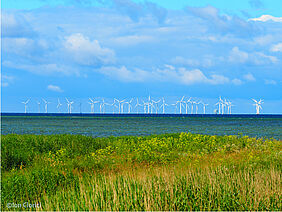With the number of wind power installations increasing around the globe every year, utilising spent material, such as blade debris, is turning into one of the most challenging issues of modern wind industry. A study conducted by the University of Cambridge found that 43 million tonnes of wind turbine blade waste are likely to be generated by 2050, most of which will be disposed of in landfills. 40 per cent of this kind of waste is expected to be produced by China; 25 per cent by Europe and 16 per cent by the United States. Therefore, the wind industry is placing particular emphasis on recycling and reusing wind turbine blades, not least because one of the main concerns in energy production nowadays is resource conservation and environmental protection. However, the small amount of recyclable materials in conventional wind turbine blades has a negative impact on the sustainability of this sector.
Now (2021), GE Renewable Energy and neowa GmbH might have found a way to help mitigate the problem blade debris poses. They have entered into an MOU for the dismantling of decommissioned Germany-based onshore wind turbines and recycling of a variety of components, including blades, during partial and full repowering. The companies also plan to jointly expand neowa’s blade recycling technology for other countries in Europe.
The agreement stipulates that neowa will be in charge of deinstallation services to GE Renewable Energy and its customers, which will comprise dismantling and removing decommissioned turbines from the turbine pad, as well as recycling various components. neowa plans to recycle up to 90% of the mass of the wind turbine. Moreover, neowa will employ its patented process and tools to comminute wind turbine blades into pellets of varying sizes for use as feedstock in cement production. The cement resulting from this process can then be used, for example, to build cement foundations and towers for new turbines.
neowa GmbH is a company which plans, implements and operates industrial waste management facilities. Its chief aim is to provide waste management services, manages material flows founded on expert knowledge and personnel to help reduce CO2 emissions and enable sustainable material recycling. It can look back on a successful history of supplying composite materials to the cement industry.
For the recycling process, neowa will cooperate with neocomp GmbH and use this company’s innovative and environmentally friendly recycling system. With the help of this system, discarded rotor blades from the wind power industry can be processed and turned into high-quality recycled fibres. Neocomp has 30 years of experience in the area of recycling and waste management. With the help of this system, glass reinforced plastic waste is turned into a high-quality substitute for the cement industry in the processing plant, which provides both energy and raw materials (SiO2).
GE Renewable Energy’s role in the MOU will consist in propagating circular lifecycle solutions in markets worldwide. The company has recently announced a number of key agreements and partnerships, including a similar multi-year agreement with Veolia North America last year, to recycle blades removed from turbines during repowering activities in the United States.
The advantages of using circular lifecycle solutions in wind blade recycling are manifold: the process produces approximately 20%+ less CO2 compared to conventional processes, and most importantly continues the lifecycle circularity of the product. The cooperation agreement with neowa will ensure that nearly 100% of the blade material will get processed and be ready for reuse.
This project is the next step in GE’s attempt to bring circular solutions to the European market and help enable the European Commission’s new Circular Economy Action Plan – one of the main blocks of the European Green Deal which stipulates the repowering or decommissioning of nearly 10 GW of aging turbines in Europe by 2025.
